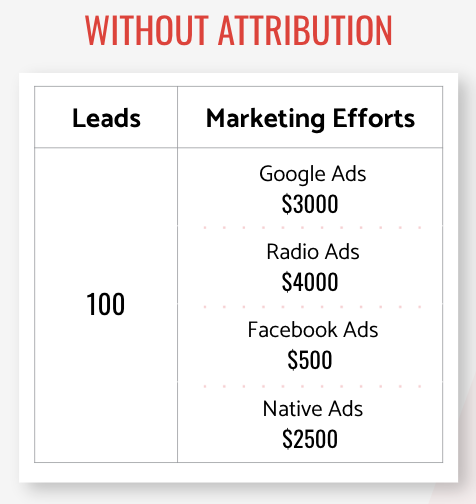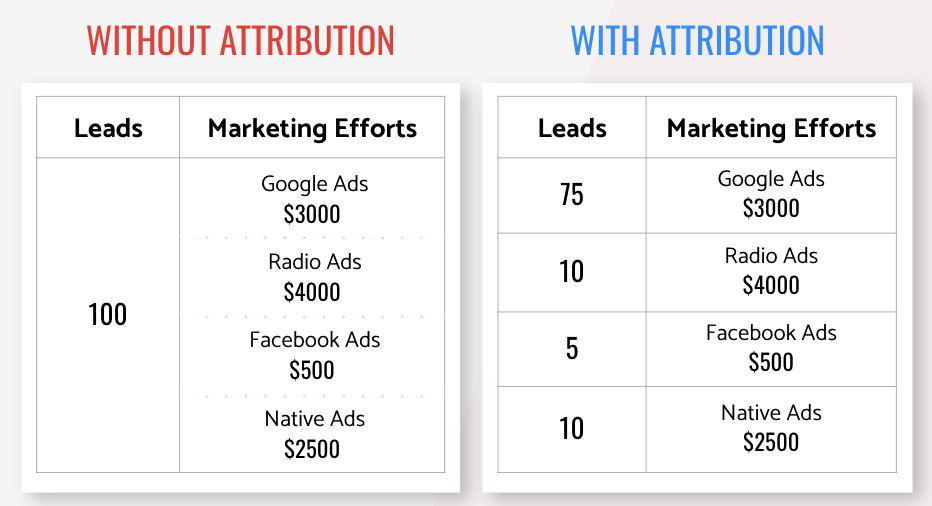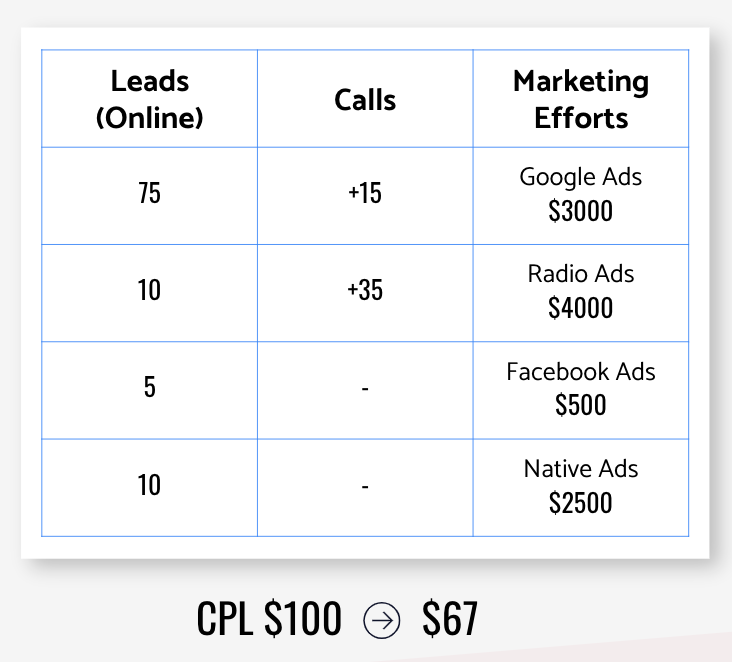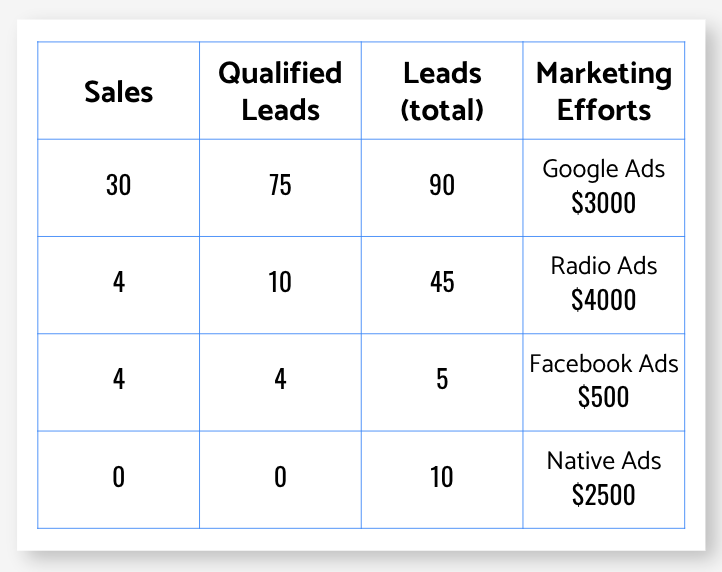How to Use Attribution Data to Make Smarter Marketing Decisions
This is not a post where we’ll define marketing attribution or how to choose a marketing attribution model. We’ve got great articles for that elsewhere. What we want you to walk away from this post with is how to strategically analyze attribution data and start making data-backed decisions. Let’s walk through how marketing attribution adds immediate value for your teams, especially once you’ve got accurate attribution. We’ll look at some example data based on a typical marketing budget and channel mix to visualize how increased visibility can drastically change your decision-making. Let’s start from the beginning, with zero attribution.
Marketing Without Attribution
You’re a modern marketer, so it’s hard to imagine you’re working with no attribution, but it still makes sense to start here. For a marketing team with no attribution strategy or monitoring, you should still know at least two things:
- How much money you’ve spent
- How many conversions have been generated

That’s a great starting point. In theory, if your marketing is working your leads will increase as spend increases. If it’s not working, your leads will be flat or worse as you make changes. But looking at the example above, where would you add budget to increase leads? Or more likely, how would you reallocate your budget to increase leads without increasing spend? It’s impossible to know which of those marketing channels is driving the leads without more information. Of course, attribution is what will provide you with more information.
Getting Started with Attribution
Here’s where most marketers are sitting. You know a little bit more about what’s driving your leads than the example above. If you don’t, and need to know where to start, basic attribution often begins with your site analytics.
- Set up Google Analytics, where you’ll get insight into where each site visitor came from based on source, medium, and campaign.
- Build your tracking strategy
- Implement custom UTM parameters to report on your campaigns in Google Analytics in an intuitive way.
- Use Google Tag Manager or GA4 to manage custom events to track what actions are truly valuable to your team.
- Layer on your CRM
- If you use a CRM like HubSpot, you can get detailed source attribution for your contacts that fill out forms on your site.
Once you’ve set that all up, the picture starts to get a little more clear. In the example below, this team can now see that their $3000 of Google Ads spend has driven the bulk of their leads at just $40 per lead. While the poor radio ads had a higher budget and only drove 10 leads at $400 per lead.

At the end of the month, when you’re making your budgeting decisions for the next period, you can now confidently go to leadership and tell them you’ll be reallocating money away from radio into Google Ads. Right? Are online leads the only way prospects get in touch with your business? If not, you’ll need to take your attribution strategy a step further.
Advanced Attribution for the Full Picture
Chances are there’s more than one way a lead can get in touch with you or your sales team, including offline channels. When a potential customer calls, texts, chats, or slips into your social media DMs you need to have a way to attribute those too. With modern call tracking software, the kind that tracks much more than calls, you can bring online and offline lead together with full attribution.

For our example data, adding accurate attribution for more than online leads is a game changer for your budgeting plans. Google Ads is still your most efficient channel, but radio becomes your second best option for both volume and CPL. With basic attribution you might drop radio ads from your marketing mix and wonder why your revenue numbers drop more than expected. But adding in the fully attributed offline leads gives you an opportunity to reallocate budget from underperforming Facebook or native ads.
This is fake data to make a point, but if there’s even just a handful of “missing” offline conversions when you’re making big, budget-impacting decisions for your or your clients, you could be headed in the wrong direction.
Go Beyond Volume Metrics for Closed-Loop Attribution
Knowing the volume of key results like leads is huge for you and your team. It opens up the door to a lot of great data-backed decisions. You can see clearly how a dollar spent differently will impact your marketing KPIs. Ultimately though, you want to tie your marketing efforts to sales and revenue.
Not all leads are equally important to your business. Some close, some go cold, and some were unqualified from the start. Using the same modern call tracking software, you can use features to start adding a layer of quality to each lead. A couple of ways call tracking can create that closed-loop attribution include:
- Lead and call scoring to inform which leads are most likely to close, or automatically convert a lead when a sale is made.
- Conversation intelligence through call recordings and transcriptions to automatically detect purchase intent or ideal customer fit.

Bringing in lead scoring to attribute qualified and closed-won leads to our example scenario opens up an analyst to a whole new world of opportunities. Now we can look not only at cost per lead, but cost per qualified lead and even cost per acquisition (CPA) of each channel. When you have a tight budget, knowing where your dollar will go furthest to generate revenue is the quickest way to optimized campaigns. And the quickest way to look like a rockstar to your leadership team.
In the example, after all is said and done, you’re confidently moving money away from native ads, in order to ramp up your facebook ads ($125 CPA) and Google Ads ($100 CPA), and likely scaling down your radio ads ($1000 CPA).
You can be a successful marketer looking at Google Analytics and CRM data to make your strategy choices. To go from a good marketer to a great one, it’s crucial to have full visibility into how your efforts impact lead and sales volume. Get in touch with our team to see how we create that closed loop attribution to inform the entire buyer’s journey. Or keep digging deeper into how to set up your own lead and call scoring strategy to unlock your attribution’s full potential.
